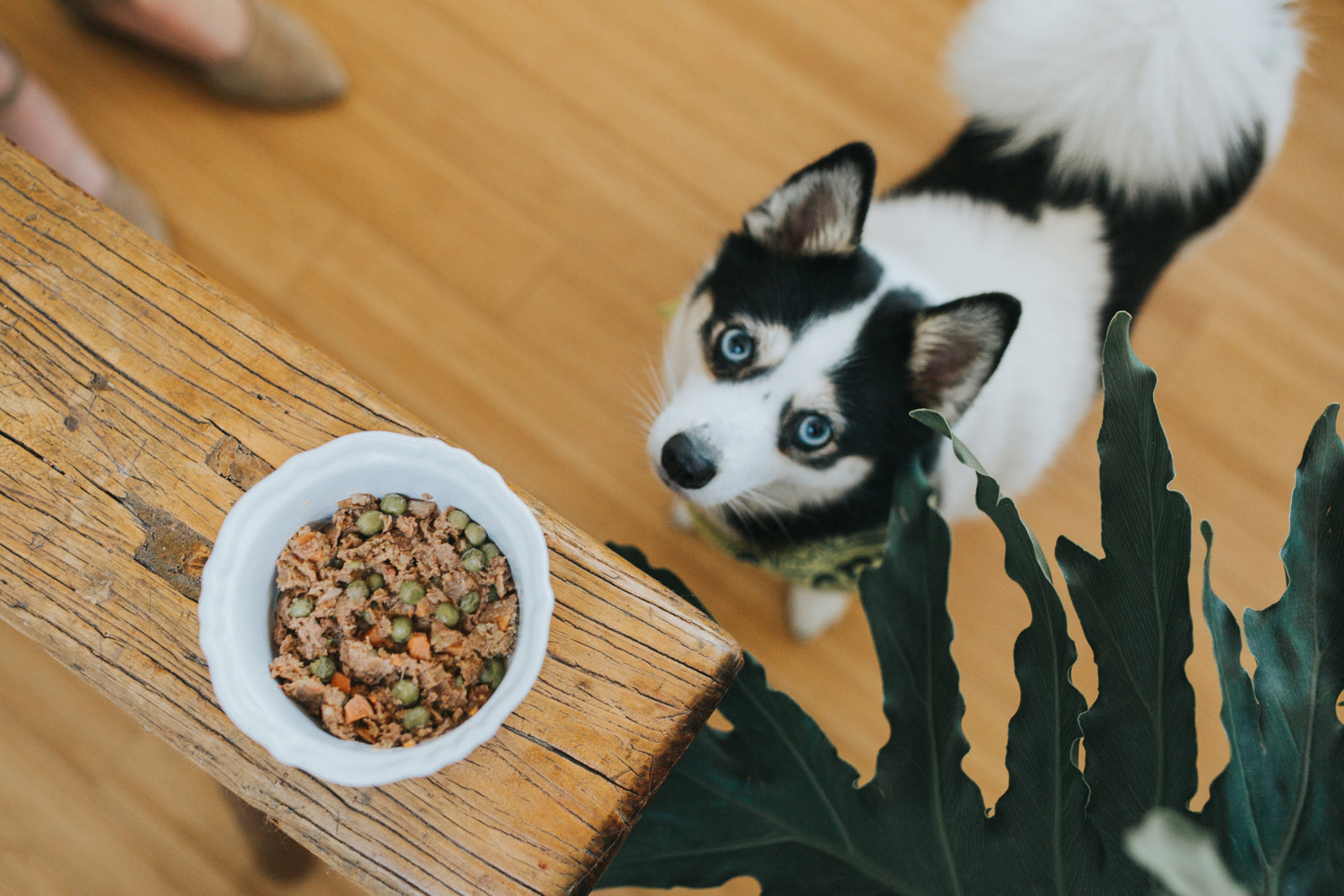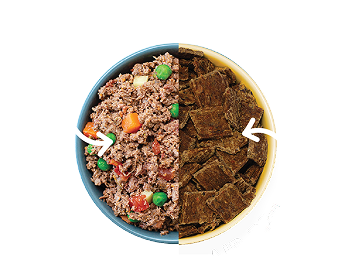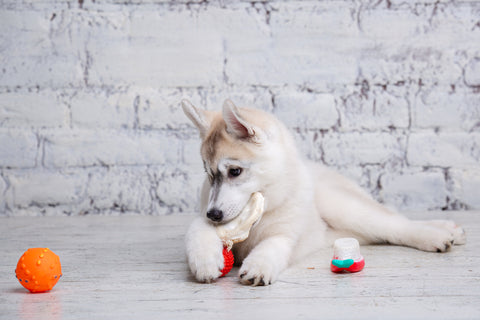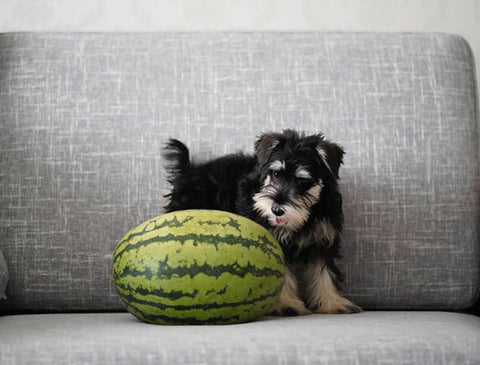
Raw Food vs. Freshly Cooked Food for Dogs
If you’ve studied up on the healthiest ways to feed your dog, you know a few things. For example, you know that a whole foods diet — meaning foods made with minimally processed ingredients — is best for your dog. Kibble and canned foods are highly processed, and include fillers and gums that can, well, gum up your dog’s digestion.
You also know that trends like “grain-free” aren’t what really matter to your dog’s health. Instead, you look for a meat-forward food where most of the protein comes from meat. Why? Because while your dog can get protein from plants, your dog actually needs taurine which is only found in meat proteins.
You might even know that you want food that is labeled “human grade” — meaning every ingredient is food safe for human consumption, and that is made in a human-grade facility — because feed-grade foods include meat byproducts from unhealthy animals.
All this knowledge leads dog owners like you to consider dog foods made with fresh, human-grade meat. But you may be confused as to whether raw or cooked meat is better for your dog. Since raw dog foods are often marketed as “fresh” or “frozen,” many dog owners ask about the difference between cooked vs. raw dog food.
A dog owner also might say, “Do dogs prefer raw meat over cooked because it’s closer to a wolf-like diet?” And though your dog is definitely descended from wolves, the answer could be yes or no, depending on your particular pooch.
Raw food diets are great for dogs, but not all families or dogs prefer them. At A Pup Above, we believe that when comparing raw vs. cooked meat for dogs, meat-forward, human-grade whole foods cooked at low-heat is the best option for you and your pups’ health. We have three big reasons for that belief:
1) Raw Meat’s Pathogens
2) Cooked Food’s Digestibility
3) Equal Whole Foods Nutrition
Let’s break it down.
Is raw or cooked meat better for dogs?
If you’re choosing between raw or cooked meat for dogs, remember that with raw, there’s no cooking process to eliminate potential pathogens like Listeria or Salmonella.
Seems obvious, but just as with any other raw meat in your kitchen, you need to think through the process of storing, preparing, and cleaning up after a raw meat dog food diet like you would in cooking a nice steak dinner for yourself.
Some households with small kids crawling around, older grandparents visiting often, or other family members with compromised immune systems may prefer a fresh, gently cooked dog food over raw food. Gently cooked fresh food is just as nutritionally sound for your dog, and cuts down pathogen risks dramatically.
If you do go with a raw meat dog food, be sure to serve raw meat fresh but well thawed. Dogs don’t want to find their dinner frozen in the middle any more than you would! Then, be sure your dog eats it within a short time period to avoid pathogen growth — a best feeding practice for dogs, regardless of what food you choose to feed them.
With raw meat, you’ll need to discard any uneaten portions from your dog’s bowl, and be aware of the reduced shelf-life of any leftovers in your fridge. Finally, be sure to clean dog dishes thoroughly and right away to keep pathogens from becoming a problem in the house.
If you decide to go with a raw meat dog food, just be sure to handle it safely, be aware of all the surfaces any raw meat touches, and wash all of those surfaces and your hands on the regular.
What’s the story with digestibility of raw vs. cooked meat for dogs?
Raw meat may be closer to a dog’s natural diet, but cooked meat may both be easier for you to handle and for your dog to digest — and it may even get your pooch more excited about eating. The reason comes down to digestion, smell, and texture.
First, let’s discuss digestion. Dogs need to get the majority of their protein from meat. Many raw dog food diets are 90%+ meat — but too much of a good thing may not be the best for your dog’s digestion. Diets that are this high in meat are also high in fat. For some dogs, excess fat can lead to digestive problems.
With gently cooked foods, more vegetables are incorporated into the recipe. This offers more healthy sources of fiber to aid in digestion. In short, if your dog has a sensitive stomach or seems to have trouble digesting a raw food diet, gently cooked foods could be the perfect solution.
Next, let’s discuss cooking. The thing is that cooking makes meat taste better! Meat that gently simmers along with other tasty and beneficial ingredients — like parsley for sweet breath, and more — gets tender, tasty, and fragrant. A picky dog may prefer cooked meat over raw food simply because cooked meals smell so amazing.
Definitely choose a raw or gently cooked food option for your dog before dry food. There’s no research that proves whether raw or cooked meat is more digestible for dogs, but there is research showing that animals digest whole food diets better than kibble or other highly processed canned foods.
If you choose a cooked meat dog food, look for gentle cooking methods, like sous-vide cooking, and minimal processing that allows whole food nutrition for your dog. A Pup Above is a great example.
Is cooked food less nutritious for my dog?
Raw foods for dogs are just that — raw meat — which takes minimal processing to the extreme. But gently cooked foods can deliver all the same whole food nutrition without the extra safe handling considerations or possible stomach upsets that come with raw meat.
And of course, your dog gets no nutrition from a raw foods diet if they turn their nose up at raw foods! So whether you choose raw or cooked meat might come down to checking in on what your doggy love … loves!
A Pup Above is a fresh food brand that uses meat certified by the USDA for human consumption — cuts of meat commonly found on our plates. The food is made in a human food facility so all ingredients are handled according to the same standards that human food is. Then, it’s cooked slowly to keep it tender, juicy, and pathogen free. That means it can keep longer in your fridge, too.
Now it’s true that the process of cooking meat could create nutrient loss to the cooking water. But A Pup Above avoids all that with a super smart “sous vide” cooking method. Meat is simmered inside of food-safe bags to lock in all of those healthy nutrients and create a naturally hydrating, collagen-rich gravy. You get nutrition on par with a raw food diet in a safer, tastier, easier-to-manage format.
At the end of the day, a fresh, whole foods diet is best for your dog. Whether you choose raw or cooked dog food, choose a high quality, meat-forward brand. Gently cooked meat isn’t raw like a wolf would eat, but it’s still minimally processed for optimal nutrition. It’s not only good for your pet, it’s good for the humans who handle your dog’s food — meaning you and your family.
If your dog loves raw, go for it. If not, know that gentle cooking brings out flavor and fragrance that may tempt your sweet pup — and you get fewer pathogens, fats, and perhaps a bit more convenience start-to-finish.
Plus, if you’ve ever seen a dog getting ready to eat a dinner of A Pup Above, you’ll know what I know — regardless of whether dogs do prefer cooked or raw meat, the delicious gravy that comes from the A Pup Above gentle, slow-cook sous-vide process makes dogs super-de-duper happy. Why not order A Pup Above sampler pack and give it a try for yourself?
Top Stories

Why Do Dogs Lick Their Paws?

Why Do Dogs Whimper & Make Noises in Their Sleep?

Healthy Vet-Approved Homemade Dog Food Recipes

How To Cook Sweet Potatoes for Dogs






















